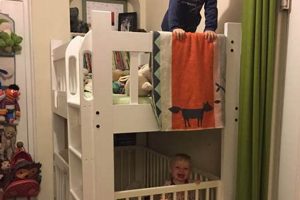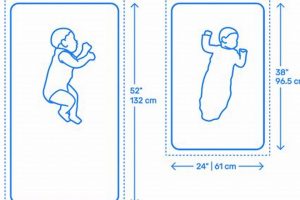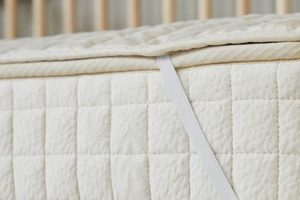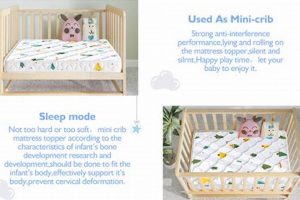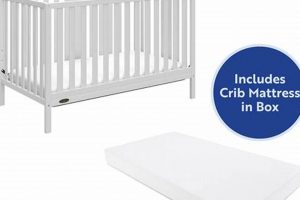The capacity of a crib mattress to permit air circulation through its materials is a key characteristic in infant bedding. This feature describes how effectively air can pass into and out of the mattress core and surface, contributing to temperature regulation and moisture dissipation. Materials and construction techniques directly influence the mattress’s ability to facilitate airflow. For instance, a mattress incorporating open-cell foam or a woven fabric cover promotes better ventilation compared to those using dense, non-porous materials.
Enhanced air circulation within a crib mattress offers several potential advantages. These include reducing the risk of overheating, minimizing moisture accumulation from perspiration or spills, and potentially contributing to a more comfortable sleep environment for the infant. Historically, concerns about Sudden Infant Death Syndrome (SIDS) have driven research and development in infant bedding, leading to increased focus on factors such as firmness and ventilation to promote safer sleep practices. The aim is to create a sleeping surface that minimizes potential hazards and optimizes infant well-being.
Therefore, understanding the design and materials that contribute to air permeability is important when selecting a crib mattress. Subsequent sections will discuss specific materials used, construction methods employed, and the impact of these factors on the overall performance and safety considerations of infant mattresses. Further discussion will focus on how these characteristics relate to industry standards and recommendations for creating a safe sleep environment.
Considerations for Air Permeable Crib Mattresses
Selecting a crib mattress requires careful evaluation of its features. The following tips offer guidance when assessing air permeability and its implications for infant safety and comfort.
Tip 1: Material Composition: Examine the materials used in the mattress construction. Open-cell foam, organic cotton, and breathable fabrics such as mesh promote better air circulation compared to closed-cell foam or vinyl.
Tip 2: Construction Design: Opt for mattresses with ventilation channels or perforated cores. These features enhance airflow throughout the mattress, aiding in temperature regulation and moisture dissipation.
Tip 3: Mattress Cover Assessment: Evaluate the cover fabric for its breathability. Tight-knit, non-porous covers impede air circulation, while loose-weave or quilted covers allow for better ventilation.
Tip 4: Firmness Evaluation: Ensure the mattress maintains appropriate firmness. Excessive softness can compromise safety, but a balance with air permeability features is essential for comfort.
Tip 5: Standards and Certifications: Seek mattresses that meet established safety standards and certifications related to breathability and material safety. These certifications indicate rigorous testing and compliance.
Tip 6: Review Independent Tests: Research independent tests and reviews that measure air permeability. Objective data from these tests offer insights into the mattress’s performance.
Tip 7: Avoid Waterproofing Excesses: While some degree of waterproofing is desirable, overly waterproofed mattresses often restrict air circulation. Balance protection with breathability.
Prioritizing air permeability in a crib mattress contributes to a safer and more comfortable sleep environment for the infant. The benefits include reduced risk of overheating, minimized moisture build-up, and improved overall sleep quality.
Careful attention to these considerations ensures an informed decision when selecting a crib mattress. Future sections will explore related aspects, such as cleaning and maintenance practices, and address frequently asked questions concerning infant sleep safety.
1. Material porosity
Material porosity is a fundamental characteristic influencing the degree to which a crib mattress permits air circulation. It directly impacts breathability, affecting temperature regulation and moisture management within the sleep environment. The inherent structure of the materials determines the ease with which air can permeate the mattress, contributing to a safer and more comfortable sleep surface for infants.
- Cell Structure and Airflow
The cell structure of foams, such as polyurethane or latex, defines its porosity. Open-cell foams exhibit interconnected cells, facilitating airflow throughout the material. Conversely, closed-cell foams possess encapsulated cells that restrict air movement. This difference directly impacts the mattress’s ability to dissipate heat and moisture.
- Fiber Arrangement in Textiles
The arrangement of fibers in mattress covers and internal padding materials also governs porosity. Woven fabrics with a looser weave allow for greater airflow compared to tightly woven or laminated materials. The selection of materials, such as organic cotton or breathable polyester blends, influences the mattress’s overall breathability.
- Density and Permeability Relationship
Material density is inversely related to permeability. High-density materials generally exhibit lower porosity and restricted airflow. Lower-density materials, characterized by larger air pockets or more open structures, tend to offer improved breathability. Manufacturers must balance density for support with the need for adequate air circulation.
- Impact on Microclimate
The porosity of mattress materials directly influences the microclimate surrounding the infant. Mattresses with high porosity promote ventilation, reducing the risk of overheating and minimizing moisture buildup. This microclimate control is crucial for maintaining a comfortable and safe sleep environment, mitigating potential health risks associated with trapped heat and humidity.
In summary, material porosity is a critical determinant of crib mattress breathability. The selection of materials with inherent porosity and the implementation of construction techniques that enhance airflow contribute significantly to the creation of a safer, more comfortable sleep surface for infants. Prioritizing materials with optimal porosity is essential for promoting a healthy sleep environment.
2. Airflow channels
Airflow channels are intentionally designed pathways within a crib mattress, serving to enhance internal air circulation. Their presence directly influences the degree to which a mattress can be considered breathable. By facilitating the movement of air through the mattress core, these channels contribute to temperature regulation and moisture dissipation, thereby mitigating potential risks associated with heat retention and humidity buildup. The effectiveness of airflow channels depends on their design, placement, and the materials from which they are constructed. For example, some mattresses incorporate vertical channels running through the foam core, while others utilize horizontal channels or a combination of both. The choice of channel design often reflects a balance between structural integrity and the desired level of air permeability. A well-designed system of airflow channels helps to create a microclimate that is more conducive to safe and comfortable infant sleep.
Real-world examples illustrate the practical significance of airflow channels. Mattresses incorporating these channels often exhibit improved heat dissipation, as demonstrated in thermal imaging studies. Such studies reveal that mattresses with effective airflow channels tend to maintain a lower and more consistent surface temperature compared to those lacking such features. Furthermore, the presence of these channels can reduce moisture accumulation, thereby minimizing the potential for microbial growth. This is particularly relevant in cases where infants may perspire during sleep or where minor spills occur. Airflow channels, therefore, play a crucial role in maintaining a hygienic sleep surface.
In conclusion, airflow channels are an integral component of a breathable crib mattress. Their design and implementation significantly impact the mattress’s ability to regulate temperature, dissipate moisture, and promote a safer sleep environment for infants. The integration of these channels represents a proactive approach to mitigating risks associated with heat retention and humidity, contributing to overall infant well-being. Challenges remain in optimizing channel design for both effectiveness and durability, but ongoing research and development continue to refine the application of this technology.
3. Cover permeability
The extent to which a crib mattress cover allows air to pass through is a crucial determinant of overall mattress breathability. Cover permeability directly influences the crib’s sleep environment by regulating heat and moisture dissipation. A cover acting as a barrier impedes airflow, potentially leading to elevated temperatures and increased humidity, while a permeable cover facilitates ventilation, contributing to a cooler, drier sleep surface. The cause-and-effect relationship is clear: lower permeability results in diminished breathability, increasing the risk of overheating and moisture accumulation, whereas higher permeability supports effective air exchange.
Cover material selection is pivotal in achieving adequate permeability. Tightly woven synthetic fabrics or those treated with waterproofing agents inherently restrict airflow. Conversely, loosely woven natural fibers, such as organic cotton or bamboo, often exhibit greater permeability. The construction of the cover also plays a significant role; quilted or layered designs can reduce airflow compared to simpler, single-layer constructions. Examples of this impact are seen in comparative studies demonstrating lower surface temperatures on mattresses featuring breathable covers compared to those with impermeable ones. Understanding this practical application is essential for informed consumer choices that prioritize infant comfort and safety.
In summary, cover permeability is a critical component of the broader concept of a breathable crib mattress. Its influence on airflow directly affects the sleep environment’s temperature and humidity levels. While balancing waterproofing needs with breathability requirements presents a challenge, prioritizing permeable cover materials and designs is essential for creating a safer and more comfortable sleep space for infants. Ongoing research focuses on developing innovative cover materials that maximize both permeability and protection, further contributing to enhanced infant sleep safety.
4. Heat dissipation
Effective heat dissipation is intrinsically linked to the breathability of a crib mattress. The ability of a mattress to dissipate heat generated by an infant’s body directly impacts the sleeping environment’s temperature, influencing comfort and safety. A mattress that inhibits heat transfer can lead to elevated surface temperatures, increasing the risk of overheating and discomfort for the infant. Conversely, a breathable mattress facilitates heat dissipation, maintaining a more consistent and comfortable temperature. The relationship is causative: increased breathability enables enhanced heat dissipation, resulting in a more regulated sleep environment.
Material composition and mattress construction significantly affect heat dissipation. Open-cell foam and breathable fabrics, for example, allow for greater airflow and thus more efficient heat transfer compared to dense, non-porous materials. Furthermore, design features such as ventilation channels can promote convective heat transfer, drawing heat away from the infant’s body. Real-world examples include mattresses designed with moisture-wicking fabrics, which facilitate evaporative cooling by drawing sweat away from the skin. The selection of appropriate materials and design features is paramount to creating a mattress capable of effectively dissipating heat, thereby reducing the likelihood of overheating.
In summary, heat dissipation is an essential component of a breathable crib mattress, with the two concepts inextricably linked. The ability of a mattress to effectively dissipate heat depends on material selection, construction techniques, and the overall breathability of the mattress. Prioritizing heat dissipation in crib mattress design contributes to a safer and more comfortable sleeping environment for infants. Challenges remain in balancing other desired characteristics, such as waterproofing, with the need for optimal heat dissipation, but ongoing research and development efforts continue to address this balance.
5. Moisture wicking
The capacity for moisture wicking directly influences the breathability and overall comfort of a crib mattress. Materials exhibiting moisture-wicking properties facilitate the movement of perspiration and other liquids away from the infant’s skin, contributing to a drier sleeping environment. This capability is not merely a comfort feature but a crucial component of a breathable mattress, as excessive moisture can impede airflow and create a breeding ground for bacteria and mold. The cause-and-effect relationship is evident: effective moisture wicking enhances air circulation, leading to a more hygienic and temperature-regulated sleep surface. For instance, mattress covers constructed from materials like merino wool or specific synthetic blends are often chosen for their ability to draw moisture away from the body, thereby promoting a cooler and drier environment. This, in turn, supports the effectiveness of other breathable components within the mattress.
The practical significance of moisture wicking extends to the reduction of skin irritation and discomfort for the infant. Prolonged exposure to dampness can lead to skin rashes and other dermatological issues. By minimizing moisture buildup, moisture-wicking materials help maintain skin integrity. Furthermore, the effectiveness of a mattress’s moisture-wicking capabilities can be readily observed. For example, comparative testing of mattresses with and without these properties often reveals significantly lower humidity levels in those incorporating moisture-wicking technologies. The application of such technologies requires careful consideration of material selection and construction techniques, ensuring the wicking action complements, rather than hinders, the mattress’s overall breathability.
In conclusion, moisture wicking is a critical attribute that contributes significantly to the effectiveness of a breathable crib mattress. Its ability to manage moisture enhances air circulation, promotes a healthier sleep environment, and reduces the risk of skin irritation. While challenges remain in optimizing the performance of moisture-wicking materials while maintaining durability and safety, the benefits of incorporating this feature are undeniable. Further research and development will likely lead to even more advanced moisture-wicking technologies, further enhancing the safety and comfort of crib mattresses.
6. Ventilation design
Ventilation design constitutes a crucial element in determining the overall breathability of a crib mattress. The strategic incorporation of ventilation features directly influences air circulation within the mattress core and across its surfaces. Inadequate ventilation design can impede airflow, leading to heat retention and moisture accumulation, thereby reducing breathability and potentially compromising infant comfort and safety. Conversely, an effective ventilation design facilitates the exchange of air, promoting a more regulated and hygienic sleep environment. The cause-and-effect relationship is clear: optimized ventilation design directly enhances crib mattress breathability. Features may include strategically placed perforations, channels, or specialized materials designed to maximize airflow while maintaining structural integrity and safety standards.
Real-world examples illustrate the practical significance of ventilation design. Mattresses incorporating three-dimensional spacer fabrics or vertically oriented ventilation channels often exhibit superior air circulation compared to those lacking such features. Independent testing can demonstrate tangible differences in temperature and humidity levels between mattresses with varying ventilation designs, providing data-driven insights for consumers. Furthermore, the application of advanced materials, such as open-cell foams with enhanced airflow capabilities, further underscores the importance of integrating ventilation design into the overall mattress construction. It’s crucial to balance ventilation with other performance requirements, such as firmness and support, to ensure optimal infant safety and comfort. Ventilation should not compromise the structural integrity of the mattress or introduce potential hazards.
In summary, ventilation design is an indispensable component of a breathable crib mattress. Its integration directly impacts the mattress’s ability to regulate temperature, dissipate moisture, and maintain a safe sleeping environment for infants. The design should enhance breathability without compromising safety or support. As research and development continue, further innovations in ventilation design promise to further improve the performance and safety of crib mattresses. Understanding the principles and practical applications of ventilation design is essential for making informed decisions when selecting a crib mattress, prioritizing infant well-being and promoting healthy sleep habits.
Frequently Asked Questions
This section addresses common inquiries regarding crib mattress breathability, providing factual information to aid in informed decision-making. The aim is to clarify misconceptions and highlight the key aspects of mattress ventilation and its implications for infant safety and comfort.
Question 1: What constitutes a “breathable” crib mattress?
A breathable crib mattress facilitates air circulation through its materials. This feature enables the dissipation of heat and moisture, contributing to a more regulated sleeping environment. Breathability is achieved through the selection of permeable materials and the incorporation of ventilation design elements.
Question 2: Why is crib mattress breathability important for infants?
Infants are particularly vulnerable to overheating. A breathable mattress reduces the risk of heat retention, contributing to a more comfortable and safer sleep environment. Adequate ventilation also minimizes moisture buildup, reducing the potential for bacterial growth.
Question 3: What materials contribute to crib mattress breathability?
Open-cell foams, such as latex or specific types of polyurethane, promote airflow due to their interconnected cellular structure. Natural fibers like organic cotton and wool, when used in covers and padding, also enhance breathability. Avoidance of dense, non-porous materials is critical.
Question 4: How do ventilation channels enhance mattress breathability?
Ventilation channels are designed pathways within the mattress core that facilitate air circulation. These channels promote the movement of air, aiding in heat dissipation and moisture evaporation. The design and placement of these channels directly impact their effectiveness.
Question 5: Does a breathable mattress guarantee prevention of Sudden Infant Death Syndrome (SIDS)?
While a breathable mattress may contribute to a safer sleep environment by reducing the risk of overheating, it is not a guarantee against SIDS. Safe sleep practices, such as placing the infant on the back and avoiding loose bedding, remain crucial.
Question 6: How can one assess the breathability of a crib mattress before purchase?
Examine the material composition and construction of the mattress. Seek certifications related to breathability and material safety. Independent tests and reviews may provide additional data on mattress ventilation performance.
Key takeaways include the importance of material selection, ventilation design, and the understanding that breathability is a contributing factor to, but not a guarantee of, infant sleep safety. Informed consumers prioritize verifiable features that promote a healthier sleeping environment.
The following section will delve into cleaning and maintenance guidelines for breathable crib mattresses, providing practical advice on maintaining hygiene and ensuring optimal performance over time.
Crib Mattress Breathable
The exploration of crib mattress breathable reveals its significance for infant sleep safety and comfort. Material selection, ventilation design, and cover permeability are primary determinants of a mattress’s ability to regulate temperature and manage moisture. These factors directly impact the sleeping environment, influencing the risk of overheating and the potential for bacterial growth.
The evidence presented underscores the importance of prioritizing crib mattress breathable characteristics in purchasing decisions. While no single factor eliminates all risks, the demonstrable benefits of enhanced breathability warrant careful consideration. Continued research and development in this area are essential to advance infant sleep safety standards and improve the well-being of future generations.


